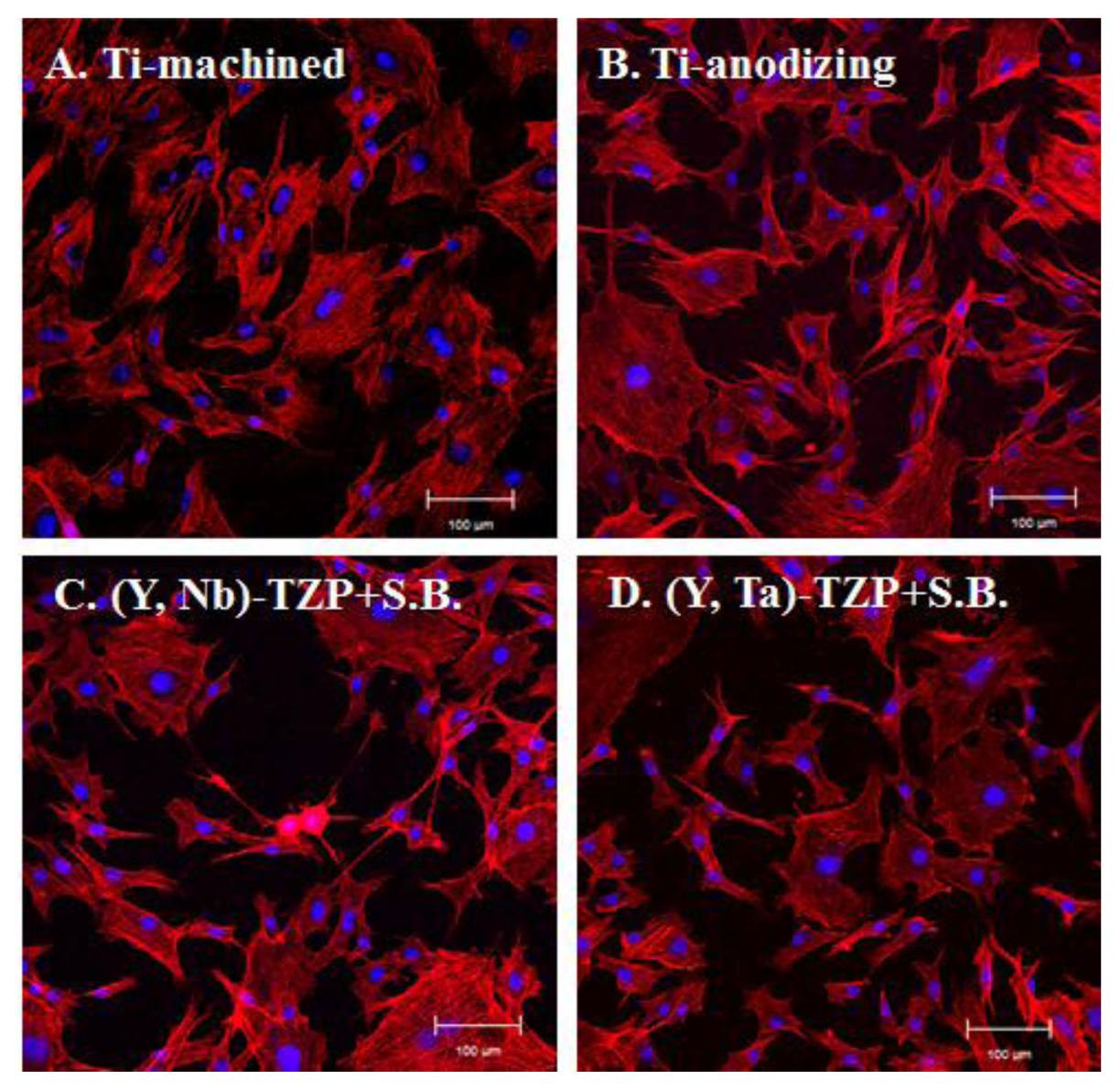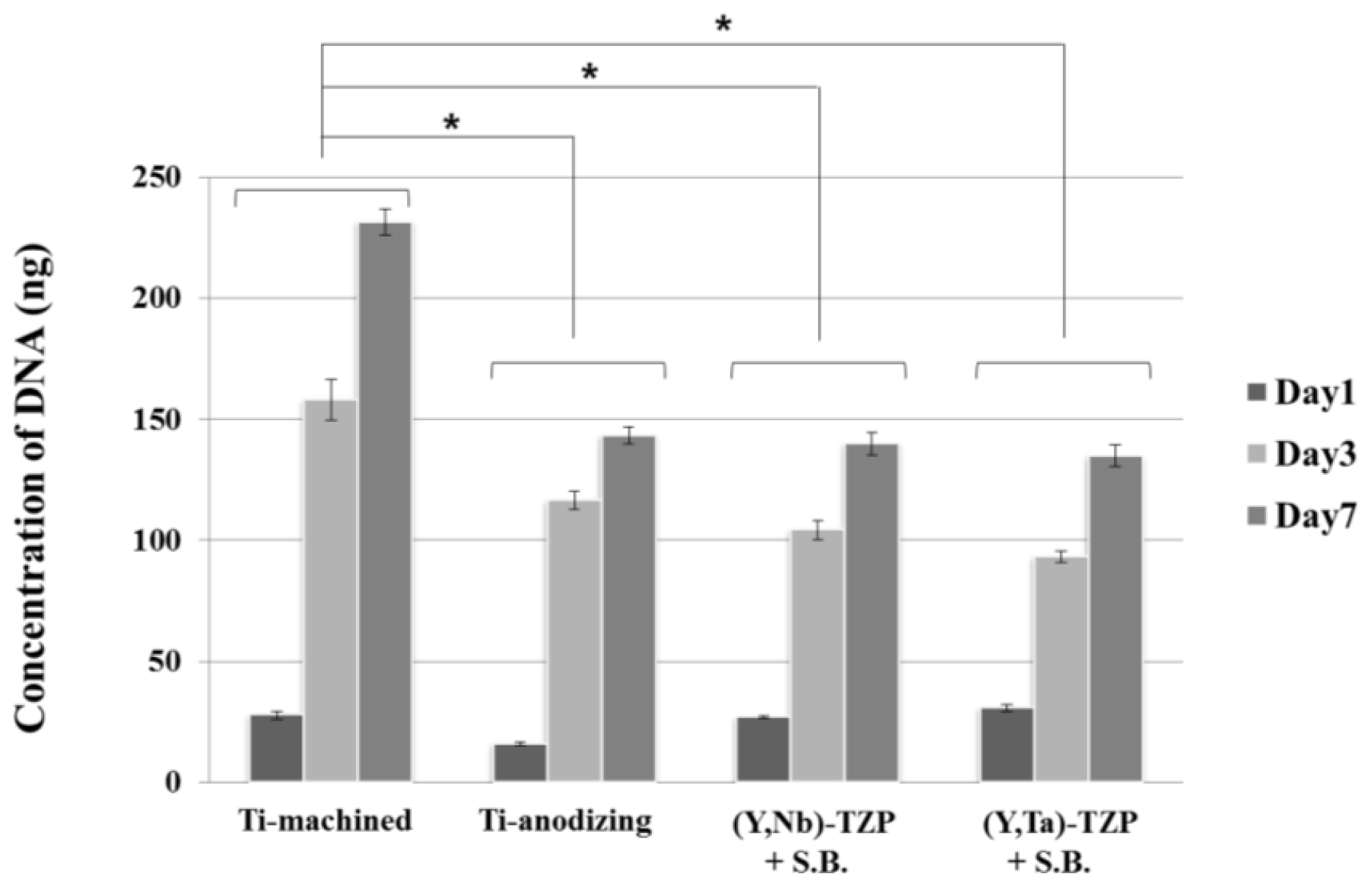Comparison of the Osteogenic Potential of Titanium- and Modified Zirconia-Based Bioceramics
Abstract
:1. Introduction
2. Results and Discussion
2.1. Results
2.1.1. Surface Analysis of the Titanium and Zirconia Discs
2.1.2. Cell Attachment and Morphology
2.1.3. Cellular Proliferation
2.1.4. Osteoblast Differentiation
2.2. Discussion
3. Experimental Section
3.1. Specimen Preparation
3.2. Surface Roughness Assessment
3.3. Cell Culture
3.4. Cell Attachment Observation
3.5. Cell Proliferation Assay
3.6. Reverse-Transcription PCR and Quantitative Real-Time PCR
3.7. Statistical Analysis
4. Conclusions
Acknowledgments
Conflicts of Interest
References
- Adell, R.; Lekholm, U.; Rockler, B.; Branemark, P.I. A 15-year study of osseointegrated implants in the treatment of the edentulous jaw. Int. J. Oral Surg. 1981, 10, 387–416. [Google Scholar]
- Adell, R.; Eriksson, B.; Lekholm, U.; Branemark, P.I.; Jemt, T. Long-term follow-up study of osseointegrated implants in the treatment of totally edentulous jaws. Int. J. Oral Maxillofac. Implant. 1990, 5, 347–359. [Google Scholar]
- De Maeztu, M.A.; Braceras, I.; Alava, J.I.; Gay-Escoda, C. Improvement of osseointegration of titanium dental implant surfaces modified with co ions: A comparative histomorphometric study in beagle dogs. Int. J. Oral Maxillofac. Surg. 2008, 37, 441–447. [Google Scholar]
- Hsu, S.H.; Liu, B.S.; Lin, W.H.; Chiang, H.C.; Huang, S.C.; Cheng, S.S. Characterization and biocompatibility of a titanium dental implant with a laser irradiated and dual-acid etched surface. Bio-Med. Mater. Eng. 2007, 17, 53–68. [Google Scholar]
- Knabe, C.; Howlett, C.R.; Klar, F.; Zreiqat, H. The effect of different titanium and hydroxyapatite-coated dental implant surfaces on phenotypic expression of human bone-derived cells. J. Biomed. Mater. Res. Part A 2004, 71, 98–107. [Google Scholar]
- Knabe, C.; Klar, F.; Fitzner, R.; Radlanski, R.J.; Gross, U. In vitro investigation of titanium and hydroxyapatite dental implant surfaces using a rat bone marrow stromal cell culture system. Biomaterials 2002, 23, 3235–3245. [Google Scholar]
- Le Guehennec, L.; Soueidan, A.; Layrolle, P.; Amouriq, Y. Surface treatments of titanium dental implants for rapid osseointegration. Dent. Mater. 2007, 23, 844–854. [Google Scholar]
- Mistry, S.; Kundu, D.; Datta, S.; Basu, D. Comparison of bioactive glass coated and hydroxyapatite coated titanium dental implants in the human jaw bone. Aust. Dent. J. 2011, 56, 68–75. [Google Scholar]
- Kanematu, N.; Shibata, K.I.; Kurenuma, S.; Watanabe, K.; Yamagami, A.; Nishio, Y.; Fujii, T. Cytotoxicity of oxide anodized titanium alloy evaluated by cell and organic culture study. Gifu Shika Gakkai Zasshi 1990, 17, 583–591. [Google Scholar]
- Cunha, C.; Sprio, S.; Panseri, S.; Dapporto, M.; Marcacci, M.; Tampieri, A. High biocompatibility and improved osteogenic potential of novel ca-p/titania composite scaffolds designed for regeneration of load-bearing segmental bone defects. J. Biomed. Mater. Res. Part A 2013, 101, 1612–1619. [Google Scholar]
- Abou Neel, E.A.; Knowles, J.C. Physical and biocompatibility studies of novel titanium dioxide doped phosphate-based glasses for bone tissue engineering applications. J. Mater. Sci. Mater. Med. 2008, 19, 377–386. [Google Scholar]
- Kawamura, Y.; Shibata, T.; Inoue, A.; Masumoto, T. Workability of the supercooled liquid in the zr65al10ni10cu15 bulk metallic glass. Acta Mater. 1998, 46, 253–263. [Google Scholar]
- Pigatto, P.D.; Guzzi, G.; Brambilla, L.; Sforza, C. Titanium allergy associated with dental implant failure. Clin. Oral Implant. Res. 2009, 20, 857. [Google Scholar]
- Siddiqi, A.; Payne, A.G.; de Silva, R.K.; Duncan, W.J. Titanium allergy: Could it affect dental implant integration? Clin. Oral Implant. Res. 2011, 22, 673–680. [Google Scholar]
- Kaur, G.; Pandey, O.P.; Singh, K.; Homa, D.; Scott, B.; Pickrell, G. A review of bioactive glasses: Their structure properties fabrication and apatite formation. J. Biomed. Mater. Res. Part A 2013. [Google Scholar] [CrossRef]
- Moller, B.; Terheyden, H.; Acil, Y.; Purcz, N.M.; Hertrampf, K.; Tabakov, A.; Behrens, E.; Wiltfang, J. A comparison of biocompatibility and osseointegration of ceramic and titanium implants: An in vivo and in vitro study. Int. J. Oral Maxillofac. Surg. 2012, 41, 638–645. [Google Scholar]
- Nakamura, K.; Kanno, T.; Milleding, P.; Ortengren, U. Zirconia as a dental implant abutment material: A systematic review. Int. J. Prosthodont. 2010, 23, 299–309. [Google Scholar]
- Piconi, C.; Maccauro, G. Zirconia as a ceramic biomaterial. Biomaterials 1999, 20, 1–25. [Google Scholar]
- Kawai, Y.; Uo, M.; Wang, Y.; Kono, S.; Ohnuki, S.; Watari, F. Phase transformation of zirconia ceramics by hydrothermal degradation. Dent. Mater. J. 2011, 30, 286–292. [Google Scholar]
- Hiromoto, S.; Tsai, A.P.; Sumita, M.; Hanawa, T. Effect of chloride ion on the anodic polarization behavior of the zr65al75ni10cu175 amorphous alloy in phosphate buffered solution. Corros. Sci. 2000, 42, 1651–1660. [Google Scholar]
- Kim, D.J. Effect of Ta2o5 Nb2O5 and HfO2 alloying on the transformability of Y2O3-stabilized tetragonal ZrO2. J. Am. Ceram. Soc. 1990, 73, 115–120. [Google Scholar]
- Sennerby, L.; Dasmah, A.; Larsson, B.; Iverhed, M. Bone tissue responses to surface-modified zirconia implants: A histomorphometric and removal torque study in the rabbit. Clin. Implant. Dent. Relat. Res. 2005, 7, S13–S20. [Google Scholar]
- Di Carlo, F.; Prosper, L.; Ripari, F.; Scarano, A. Bone response to zirconia ceramic implants: An experimental study in rabbit. J. Oral Implantol. 2000, 29, 8–12. [Google Scholar]
- Lughi, V.; Sergo, V. Low temperature degradation -aging- of zirconia: A critical review of the relevant aspects in dentistry. Dent. Mater. 2010, 26, 807–820. [Google Scholar]
- Gremillard, L.; Chevalier, J. Durability of zirconia-based ceramics and composites for total hip replacement. Key Eng. Mater. 2008, 361–363, 791–794. [Google Scholar]
- Matsui, M.; Soma, T.; Oda, I. Stress-induced transformation and plastic deformation for Y203-containing tetragonal zirconia polycrystals. J. Am. Ceram. Soc. 1986, 69, 198–202. [Google Scholar]
- United States Food and Drug Administration. Recall of zirconia ceramic femoral heads for hip implants. Am. Ceram. Soc. Bull. 2001, 80, 14–15.
- Masonis, J.L.; Bourne, R.B.; Ries, M.D.; McCalden, R.W.; Salehi, A.; Kelman, D.C. Zirconia femoral head fractures: A clinical and retrieval analysis. J. Arthroplast. 2004, 19, 898–905. [Google Scholar]
- Clarke, I.C.; Manaka, M.; Green, D.D.; Williams, P.; Pezzotti, G.; Kim, Y.H.; Ries, M.; Sugano, N.; Sedel, L.; Delauney, C.; et al. Current status of zirconia used in total hip implants. J. Bone Jt. Surg. Am. 2003, 85-A, 73–84. [Google Scholar]
- Kim, D.J.; Jung, H.J.; Jang, J.W.; Lee, H.L. Fracture toughness ionic conductivity and low-temperature phase stability of tetragonal zirconia codoped with yttria and niobium oxide. J. Am. Ceram. Soc. 1998, 81, 2309–2314. [Google Scholar]
- Ray, J.C.; Panda, A.B.; Saha, C.R.; Pramanik, P. Synthesis of niobium(v)-stabilized tetragonal zirconia nanocrystalline powders. J. Am. Ceram. Soc. 2003, 86, 514–516. [Google Scholar]
- Ray, J.C.; Panda, A.B.; Pramanik, P. Chemical synthesis of nanocrystals of tantalum ion-doped tetragonal zirconia. Mater. Lett. 2002, 53, 145–150. [Google Scholar]
- Cho, Y.D.; Yoon, W.J.; Woo, K.M.; Baek, J.H.; Lee, G.; Cho, J.Y.; Ryoo, H.M. Molecular regulation of matrix extracellular phosphoglycoprotein expression by bone morphogenetic protein-2. J. Biol. Chem. 2009, 284, 25230–25240. [Google Scholar]
- Schmalz, G.; Arenholt-Bindslev, D. Biocompatibility of dental materials. Dent. Clin. N. Am. 2007, 51, 747–760. [Google Scholar]
- Cooper, L.F. A role for surface topography in creating and maintaining bone at titanium endosseous implants. J. Prosthet. Dent. 2000, 84, 522–534. [Google Scholar]
- Rompen, E.; Domken, O.; Degidi, M.; Pontes, A.E.; Piattelli, A. The effect of material characteristics of surface topography and of implant components and connections on soft tissue integration: A literature review. Clin. Oral Implant. Res. 2006, 17, 55–67. [Google Scholar]
- Kim, D.J.; Lee, M.H.; Lee, D.Y.; Han, J.S. Mechanical properties phase stability and biocompatibility of (YNb)-TZP/Al2O3 composite abutments for dental implant. J. Biomed. Mater. Res. 2000, 53, 438–443. [Google Scholar]
- Raghavan, S.; Wang, H.; Porter, W.D.; Dinwiddie, R.B.; Mayo, M.J. Thermal properties of zirconia co-doped with trivalent and pentavalent oxides. Acta Mater. 2001, 49, 169–179. [Google Scholar]
- Shalabi, M.M.; Gortemaker, A.; Van’t Hof, M.A.; Jansen, J.A.; Creugers, N.H. Implant surface roughness and bone healing: A systematic review. J. Dent. Res. 2006, 85, 496–500. [Google Scholar]
- Orsini, G.; Assenza, B.; Scarano, A.; Piattelli, M.; Piattelli, A. Surface analysis of machined versus sandblasted and acid-etched titanium implants. Int. J. Oral Maxillofac. Implant. 2000, 15, 779–784. [Google Scholar]
- Xiao, F.X.B.; Liu, R.F.; Zheng, Y.Z. Hydoxyapatite/titanium composite coating prepared by hydrothermal-electrochemical technique. Mater. Lett. 2005, 59, 1660–1664. [Google Scholar]
- Xiao, X.F.; Liu, R.F.; Zheng, Y.Z. Hydrothermal-electrochemical codeposited hydoxyapatite/yttria-stabilized zirconia composite coating. J. Mater. Sci. 2006, 41, 3417–3424. [Google Scholar]
- Jiang, Q.H.; Liu, L.; Peel, S.; Yang, G.L.; Zhao, S.F.; He, F.M. Bone response to the multilayer BMP-2 gene coated porous titanium implant surface. Clin. Oral Implant. Res. 2013, 24, 853–861. [Google Scholar]
- Ong, J.L.; Cardenas, H.L.; Cavin, R.; Carnes, D.L., Jr. Osteoblast responses to bmp-2-treated titanium in vitro. Int. J. Oral Maxillofac. Implant. 1997, 12, 649–654. [Google Scholar]
- Lee, B.C.; Yeo, I.S.; Kim, D.J.; Lee, J.B.; Kim, S.H.; Han, J.S. Bone formation around zirconia implants combined with rhbmp-2 gel in the canine mandible. Clin. Oral Implant. Res. 2013, 24, 1332–1338. [Google Scholar]





© 2014 by the authors; licensee MDPI, Basel, Switzerland This article is an open access article distributed under the terms and conditions of the Creative Commons Attribution license (http://creativecommons.org/licenses/by/3.0/).
Share and Cite
Cho, Y.-D.; Shin, J.-C.; Kim, H.-L.; Gerelmaa, M.; Yoon, H.-I.; Ryoo, H.-M.; Kim, D.-J.; Han, J.-S. Comparison of the Osteogenic Potential of Titanium- and Modified Zirconia-Based Bioceramics. Int. J. Mol. Sci. 2014, 15, 4442-4452. https://doi.org/10.3390/ijms15034442
Cho Y-D, Shin J-C, Kim H-L, Gerelmaa M, Yoon H-I, Ryoo H-M, Kim D-J, Han J-S. Comparison of the Osteogenic Potential of Titanium- and Modified Zirconia-Based Bioceramics. International Journal of Molecular Sciences. 2014; 15(3):4442-4452. https://doi.org/10.3390/ijms15034442
Chicago/Turabian StyleCho, Young-Dan, Ji-Cheol Shin, Hye-Lee Kim, Myagmar Gerelmaa, Hyung-In Yoon, Hyun-Mo Ryoo, Dae-Joon Kim, and Jung-Suk Han. 2014. "Comparison of the Osteogenic Potential of Titanium- and Modified Zirconia-Based Bioceramics" International Journal of Molecular Sciences 15, no. 3: 4442-4452. https://doi.org/10.3390/ijms15034442




